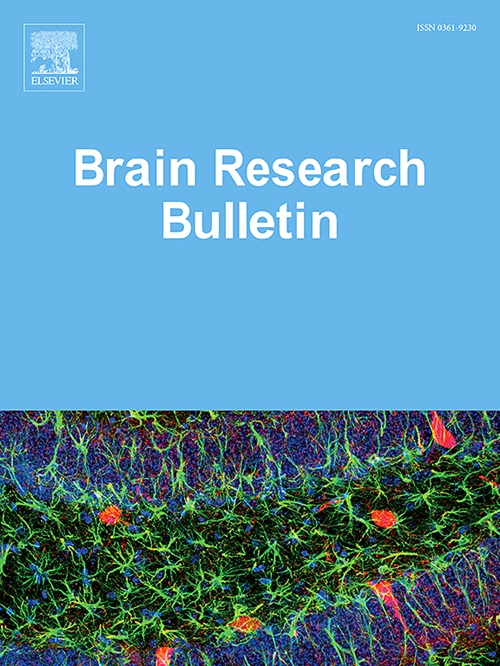BHLHE40 regulates microglia polarization after spinal cord injury via the NF-κB pathway
IF 3.5
3区 医学
Q2 NEUROSCIENCES
引用次数: 0
Abstract
Spinal cord injury (SCI) is a devastating disease characterized by neuroinflammation and irreversible neuronal loss. The basic helix-loop-helix family member e40 (Bhlhe40) is a stress-responsive transcription factor involved in the pathological process of inflammation. However, Bhlhe40 expression and its role in SCI are largely unknown. SCI rat models were established with an aneurysm clip and then the rats were injected with lentiviral Bhlhe40 shRNA to knock down Bhlhe40 expression. In vitro, BV2 microglia cells were stimulated with LPS and IFN-γ to promote M1 microglia polarization. The results showed that Bhlhe40 expression was significantly elevated in the injured spinal cord tissue. Bhlhe40 deficiency reduced neuroinflammation and neuronal loss, and then promoted the recovery of neurological function. Additionally, Bhlhe40 knockdown alleviated neuronal apoptosis by regulating microglia polarization. In our study, Bhlhe40 knockdown inhibited M1 microglia polarization and the secretion of pro-inflammatory factors (TNF-α, IL-1β, and IL-6). Meanwhile, the NF-κB pathway was inhibited after the Bhlhe40 knockdown in SCI rats. To further explore the functional role of Bhlhe40, we performed in vitro experiments. Bhlhe40 knockdown decreased M1 microglia polarization by inhibiting the NF-κB pathway. In conclusion, our study indicates that Bhlhe40 knockdown can alleviate the progression of SCI and its underlying mechanism in regulating macrophage polarization through the NF-κB pathway.
BHLHE40通过NF-κB途径调节脊髓损伤后小胶质细胞的极化。
脊髓损伤(SCI)是一种破坏性疾病,其特征是神经炎症和不可逆的神经元损失。基本螺旋环-螺旋家族成员 e40(Bhlhe40)是一种应激反应转录因子,参与了炎症的病理过程。然而,Bhlhe40的表达及其在SCI中的作用在很大程度上是未知的。通过动脉瘤夹建立 SCI 大鼠模型,然后给大鼠注射慢病毒 Bhlhe40 shRNA 以敲除 Bhlhe40 的表达。在体外,用 LPS 和 IFN-γ 刺激 BV2 小胶质细胞以促进 M1 小胶质细胞极化。结果显示,Bhlhe40在损伤脊髓组织中的表达明显升高。缺乏Bhlhe40可减轻神经炎症和神经元损失,进而促进神经功能的恢复。此外,Bhlhe40敲除还能通过调节小胶质细胞极化减轻神经元凋亡。在我们的研究中,Bhlhe40敲除抑制了M1小胶质细胞的极化和促炎因子(TNF-α、IL-1β和IL-6)的分泌。同时,Bhlhe40敲除后,SCI大鼠的NF-κB通路受到抑制。为了进一步探讨Bhlhe40的功能作用,我们进行了体外实验。通过抑制 NF-κB 通路,Bhlhe40 基因敲除降低了 M1 小胶质细胞的极化。总之,我们的研究表明,敲除Bhlhe40可以缓解SCI的进展,其基本机制是通过NF-κB通路调节巨噬细胞的极化。
本文章由计算机程序翻译,如有差异,请以英文原文为准。
求助全文
约1分钟内获得全文
求助全文
来源期刊

Brain Research Bulletin
医学-神经科学
CiteScore
6.90
自引率
2.60%
发文量
253
审稿时长
67 days
期刊介绍:
The Brain Research Bulletin (BRB) aims to publish novel work that advances our knowledge of molecular and cellular mechanisms that underlie neural network properties associated with behavior, cognition and other brain functions during neurodevelopment and in the adult. Although clinical research is out of the Journal''s scope, the BRB also aims to publish translation research that provides insight into biological mechanisms and processes associated with neurodegeneration mechanisms, neurological diseases and neuropsychiatric disorders. The Journal is especially interested in research using novel methodologies, such as optogenetics, multielectrode array recordings and life imaging in wild-type and genetically-modified animal models, with the goal to advance our understanding of how neurons, glia and networks function in vivo.
 求助内容:
求助内容: 应助结果提醒方式:
应助结果提醒方式:


